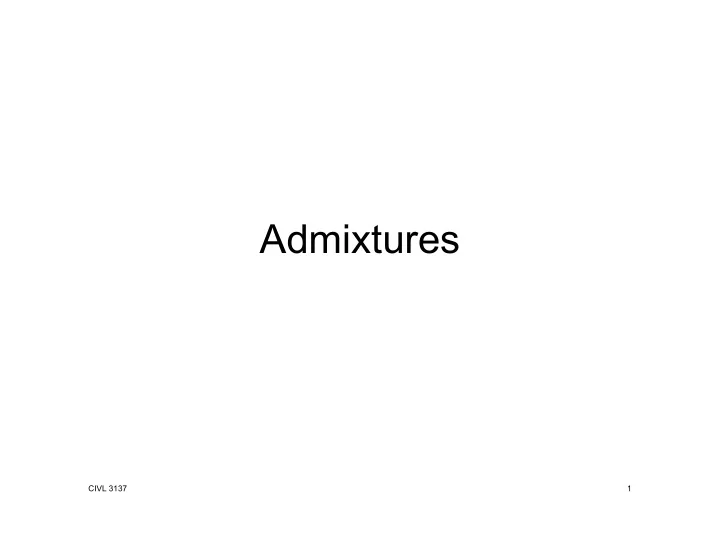

Admixtures CIVL 3137 1
Admixtures admixture ( n .) any material other than water, aggregates, hydraulic cement and fiber reinforcement, used as an ingredient of concrete or mortar, and added to the batch immediately before or during mixing. CIVL 3137 2
Types of Admixtures 1. Air-entraining admixtures added to improve freeze-thaw durability 2. Chemical admixtures water-soluble compounds used to improve the properties of the fresh concrete 3. Mineral admixtures finely divided solids usually added to improve the strength of the hardened concrete CIVL 3137 3
Air Entrainment Goals tiny air bubbles, uniform in size uniform dispersion in cement paste air content = 9% of mortar volume one billion bubbles per cubic yard CIVL 3137 5
Air Entrainment In Roman times, ox blood was used to improve durability (though I’m not sure they knew why). Rediscovery in modern times due to accidental observation that freeze-thaw resistant sections of some roads had been made with cement that had been contaminated with beef tallow added as a grinding aid. CIVL 3137 7
Air Entrainment hydrophilic group(s) hydrophobic component CIVL 3137 8
Air Entrainment Repulsion between negative surface charges prevents coalescence CIVL 3137 9
Air Entrainment CIVL 3137 10
Chemical Admixtures set accelerators set retarders water reducers stabilizers CIVL 3137 12
Chemical Admixtures • Type A – water reducing • Type B – retarding • Type C – accelerating • Type D – water reducing and retarding • Type E – water reducing and accelerating • Type F – high-range water reducing (HRWR) • Type G – HRWR and retarding • Type S – specific performance admixtures CIVL 3137 14
Set Accelerators Typically used in cold weather to reduce setting and curing times; also used to speed removal of formwork Salts (calcium chloride, sodium chloride) are cheap set accelerators but can corrode rebar and reduce resistance to sulfate attack Nitrates and nitrites are less effective and more expensive but are also non-corrosive CIVL 3137 15
Set Retarders Typically used in hot weather to slow setting and curing so concrete can be finished; also used in mass pours to eliminate cold joints Sugars, starches, and cellulose derivatives are absorbed onto the surface of cement particles to delay hydration of the calcium silicates As little as 0.05% by mass will delay setting for four hours; 1% prevents setting completely CIVL 3137 16
Stabilizers Lets leftover concrete be returned to plant and reused the next day Forms protective barrier around cement grains to prevent hydration of both calcium silicates and calcium aluminates for up to 72 hours Activator dissolves the protective barrier and lets setting proceed in a normal manner with no harm to the concrete CIVL 3137 17
Water Reducers low-range (5-10% reduction) mid-range (10-15% reduction) high-range (15-30% reduction) “superplasticizers” CIVL 3137 18
How Water Reducers Work CIVL 3137 19
Using Superplasticizers CIVL 3137 20
Drawback: Slump Loss without super Slump - in with super CIVL 3137 21
Supplementary Cementitious Materials (Mineral Admixtures) CIVL 3137 22
Mineral Admixtures Natural Pozzalans Artificial Pozzalans volcanic ash fly ash diatomaceous earth silica fume rice husk ash blast furnace slag calcined clays (metakaolin) CIVL 3137 23
Pozzalans pozzalan ( n .) siliceous materials which by themselves have little or no cementitious value but will, in finely divided form and in the presence of moisture, chemically react with calcium hydroxide (CH) at ordinary temperatures to form compounds (CSH) that have cementing properties. CIVL 3137 25
Hydration Chemistry water calcium hydroxide crystals CS H CSH CH heat calcium silicate calcium silicate hydrate gel CIVL 3137 26
True Pozzalans silicates (high in SiO 2 ) high specific surface (fine powder) usually glassy (no crystals) usually spherical CIVL 3137 27
Natural Pozzolans volcanic ash diatomaceous earth rice husk ash calcined clay (metakaolin) CIVL 3137 28
Fly Ash CIVL 3137 29
Silica Fume CIVL 3137 30
Uses of Pozzalans Save money by replacing expensive cement Lower heat of hydration due to slow strength gain Increase sulfate resistance if low in alumina Improve workability due to spherical shape Increase strength by converting CH to CSH CIVL 3137 31
Effects on Strength CIVL 3137 32
Fly Ash Tiny spheres of glassy silica and alumina that are electrostatically precipitated from exhaust gases given off by coal-fired power plants Anthracite = Class F fly ash Lignite = Class C fly ash CIVL 3137 35
Fly Ash The primary difference between Class C and Class F fly ash is the chemical composition of the ash itself. Class F fly ash is highly pozzolanic, meaning that it reacts with calcium hydroxide during hydration of the portland cement to form calcium-silicate-hydrate. Class C fly ash is pozzolanic but also has cementitious properties all by itself. CIVL 3137 36
Blast Furnace Slag Formed when iron ore, coke and a flux (either limestone or dolomite) are melted together in a blast furnace to produce molten iron Air cooled slag Pelletized slag Granulated slag CIVL 3137 37
Granulated Slag Granulated slag is rapidly cooled by large quantities of water to produce a sand-like granule that is primarily ground into a cement known as Ground Granulated Blast Furnace Slag (GGBS), or Type S slag cement. It is also mixed with Portland cement clinker to make a blended Type 1S cement. http://www.nationalslag.org/blast-furnace-slag CIVL 3137 41
Granulated Blast Furnace Slag CIVL 3137 42
GGBFS CIVL 3137 43
Silica Fume Tiny spheres of glassy silica electrostatically precipitated from exhaust gases given off by electric arc furnaces used to make silicon Carbon-free = white silica fume Carbonaceous = black silica fume CIVL 3137 46
RAW MATERIAL HANDLING 1 AND TRANSPORT C Si0 2 2 OFF-GAS ELECTRODES CHARGE FEED RECOVERED ENERGY SILICA FUME ELECTRIC ARC FURNACE TAPPING AND 3 REFINING CRUSHING AND 5 SIZING OF PRODUCT 4 SOLIDIFICATION SILICON CIVL 3137 47
Silica Fume 16000 705 lb/yd 3 cement 12000 102 lb/yd 3 silica fume Strength (psi) 8000 705 lb/yd 3 cement 4000 0 0 10 20 30 40 50 60 Age (days) CIVL 3137 48
Recommend
More recommend